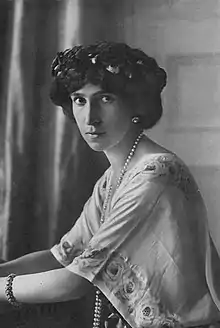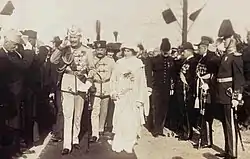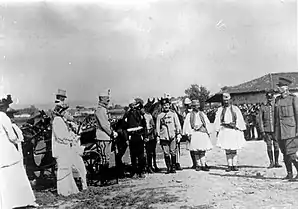Sophie, Princess of Albania
Princess Sophie of Schönburg-Waldenburg (Sophie Helene Cecilie Prinzessin von Schönburg-Waldenburg; 21 May 1885 – 3 February 1936) was the consort of Prince Wilhelm of Wied. With her husband's accession to the Albanian throne she became the Princess of Albania (Albanian: Princeshë e Shqipërisë). Outside the country and in diplomatic correspondence, she was styled "Princess consort", but in Albania she was referred to as Mbretëreshë, or Queen.
| Princess Sophie | |||||
|---|---|---|---|---|---|
| Princess of Albania | |||||
 | |||||
| Born | 21 May 1885 Potsdam, Brandenburg, German Empire | ||||
| Died | 3 February 1936 (aged 50) Fântânele, Romania | ||||
| Spouse | Wilhelm, Prince of Albania | ||||
| Issue | Marie Eleonore, Princess Alfred of Schönburg-Waldenburg Carol Victor, Hereditary Prince of Albania | ||||
| |||||
| House | House of Schönburg-Waldenburg (by birth) House of Wied-Neuwied (by marriage) | ||||
| Father | Victor, Hereditary Prince of Schönburg-Waldenburg | ||||
| Mother | Princess Lucia of Sayn-Wittgenstein-Berleburg | ||||
Early life
Princess Sophie was born in Potsdam, Brandenburg, Prusia, as daughter of Hereditary Prince Otto Karl Viktor I von Schönburg-Waldenburg (1856-1888) and Princess Lucie zu Sayn-Wittgenstein-Berleburg (1859-1903).
Both of Princess Sophie's parents died when she was young, so she spent much of her youth at the Castle Hemius in Fântânele estate in Moldavia, which was owned by her maternal relatives.[1]
Marriage and issue
On 30 November 1906 at Waldenburg, Saxony Princess Sophie married Prince Wilhelm of Wied, son of William, Prince of Wied (1845-1907) and Princess Marie of the Netherlands (1841-1910). Sophie's husband, Prince Wilhelm was related to Wilhelm II, German Emperor, being his second cousin. They had two children:
- Princess Marie Eleonore of Albania (1909–1956) ⚭ Prince Alfred of Schönburg-Waldenburg (1905-1941), son of Prince Heinrich of Schönburg-Waldenburg and Princess Olga of Löwenstein-Wertheim-Freudenberg ⚭ Ion Octavian Bunea (1899-1977)
- Carol Victor, Hereditary Prince of Albania (1913–1973) ⚭ Eileen de Coppet (1922-1985)
Albanian ancestry
She had some remote Albanian ancestry, being a descendant of Princess Elena Callimachi, daughter of Prince Scarlat Ghica (1715-1766), who was Prince of Moldavia and Prince of Wallachia, and Princess Ruxandra Muruzi. She was also descended from Princess Ruxandra Ghica, daughter of Grigore I Ghica (1628-1675), Prince of Wallachia and Princess Maria Strurdza. Although officially Romanian, the Ghica Princely family has Albanian roots.[2]
Princess of Albania
| Styles of Princess (Queen)[3] Sophie of Albania | |
|---|---|
| Reference style | Her Highness |
| Spoken style | Your Highness |

Princess Sophie was close to her husband's aunt Queen Elisabeth of Romania, whom she had known since moving to Romania after the death of her parents. Princess Sophie and Queen Elisabeth sang, painted, composed and played musical instruments together.[4] Queen Elisabeth played an important role in getting Princess Sophie's husband William the Albanian throne by asking Take Ionescu to persuade the great powers to select William.[5] Princess Sophie and Queen Elisabeth both worked to overcome William's reluctance to accept the throne.[1]
Eventually William agreed, and on 21 February 1914, Prince William and Princess Sophie hosted a delegation of Albanian notables at their castle in Neuwied, where William was formally offered the throne. The Albanian delegation then visited Waldenburg, Saxony, where they paid their respects to Princess Sophie's family.[1]
Sophie and her husband arrived in Albania on 7 March 1914, in Durrës, the provisional capital. Sophie and Wilhelm did not make a success in Albania, were they were strangers to the local culture and introduced habits which were normal fr royalty in Western Europe but previously unknown in Albania. Edith Durham, who met them in Durrës, described them:
- "They are very royal – both of them [...] keep a court and keep people standing in their presence. It is all ludicrous [...] her [Sophie's] only idea is to play lady bountiful, distribute flowers, put medals on the wounded and make tiny blouses of native embroidery."[6]
Sophie showed no interest in politics. Her representational duties and dissiterest in state affairs were considered ideal for a royal consort in Western Europe and modelled after her mentor queen Elizabeth of Romania, but in Albania the role she played were considered silly and completely superflous.[6]
However, her Albanian adventure proved short-lived. On 3 September 1914, with the country in turmoil, Princess Sophie and Prince William left Albania, never to return.[7] However, she officially remained the Princess of Albania until 31 January 1925, when the country was declared a republic.
Ancestry
| Ancestors of Sophie, Princess of Albania | |||||||||||||||||||||||||||||||||||||||||||||||||||||||||||||||||||||||||||||||||||||||||||||||||||||||||||||||||||||||||||||||||||||||||||||||||||||||||||||||||||||||||||||||||||||||||||||||||||||||||||||||||||||||||||||||||||||||||||||||||||||||||||||||||||||||||||||||||||||||||
|---|---|---|---|---|---|---|---|---|---|---|---|---|---|---|---|---|---|---|---|---|---|---|---|---|---|---|---|---|---|---|---|---|---|---|---|---|---|---|---|---|---|---|---|---|---|---|---|---|---|---|---|---|---|---|---|---|---|---|---|---|---|---|---|---|---|---|---|---|---|---|---|---|---|---|---|---|---|---|---|---|---|---|---|---|---|---|---|---|---|---|---|---|---|---|---|---|---|---|---|---|---|---|---|---|---|---|---|---|---|---|---|---|---|---|---|---|---|---|---|---|---|---|---|---|---|---|---|---|---|---|---|---|---|---|---|---|---|---|---|---|---|---|---|---|---|---|---|---|---|---|---|---|---|---|---|---|---|---|---|---|---|---|---|---|---|---|---|---|---|---|---|---|---|---|---|---|---|---|---|---|---|---|---|---|---|---|---|---|---|---|---|---|---|---|---|---|---|---|---|---|---|---|---|---|---|---|---|---|---|---|---|---|---|---|---|---|---|---|---|---|---|---|---|---|---|---|---|---|---|---|---|---|---|---|---|---|---|---|---|---|---|---|---|---|---|---|---|---|---|---|---|---|---|---|---|---|---|---|---|---|---|---|---|---|---|---|---|---|---|---|---|---|---|---|---|---|---|---|---|---|---|
| |||||||||||||||||||||||||||||||||||||||||||||||||||||||||||||||||||||||||||||||||||||||||||||||||||||||||||||||||||||||||||||||||||||||||||||||||||||||||||||||||||||||||||||||||||||||||||||||||||||||||||||||||||||||||||||||||||||||||||||||||||||||||||||||||||||||||||||||||||||||||
References
- Heaton-Armstrong, Duncan (2005). The Six Month Kingdom: Albania 1914. I.B.Tauris. pp. xii, 14. ISBN 1-85043-761-0.
- http://www.ghika.net/Histoire/Question_Orient.pdf The Ghica family was a Greek Orthodox Phanariote dynasty of Albanian origin
- Outside the country and in diplomatic correspondence, she was styled "Princess Consort", but in Albania she was referred to as Queen.
- Edinburgh, Marie of (1971). The story of my life. Ayer Publishing. pp. 541, 542. ISBN 0-405-02761-3.
- Pearson, Owen (2006). Albania in the Twentieth Century: a history. I.B.Tauris. pp. 50, 377. ISBN 1-84511-013-7.
- Tanner, M. (2014). Albania's Mountain Queen: Edith Durham and the Balkans. Bloomsbury Publishing. p. 192. ISBN 978-0-85772-374-1.
- Hall, Richard C. (2000). The Balkan Wars, 1912–1913: Prelude to the First World War. Routledge. pp. 131. ISBN 0-415-22946-4.
External links
- Marek, Miroslav. "A listing of Princes of Schönburg-Waldenburg since 1800 and their descendants". Genealogy.EU.
 1913
1913_%2526_family_LCCN2014695081.tif.jpg.webp) 1913
1913 Prince Wilhelm of Wied, Isa Boletini and officers of the International Gendarmerie: Duncan Heaton-Armstrong and Colonel Thomson near Durrës in June 1914
Prince Wilhelm of Wied, Isa Boletini and officers of the International Gendarmerie: Duncan Heaton-Armstrong and Colonel Thomson near Durrës in June 1914